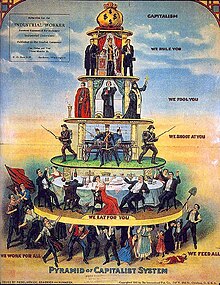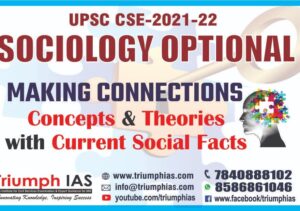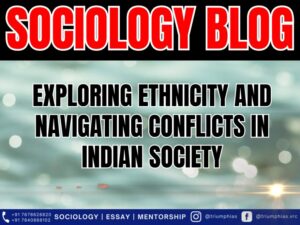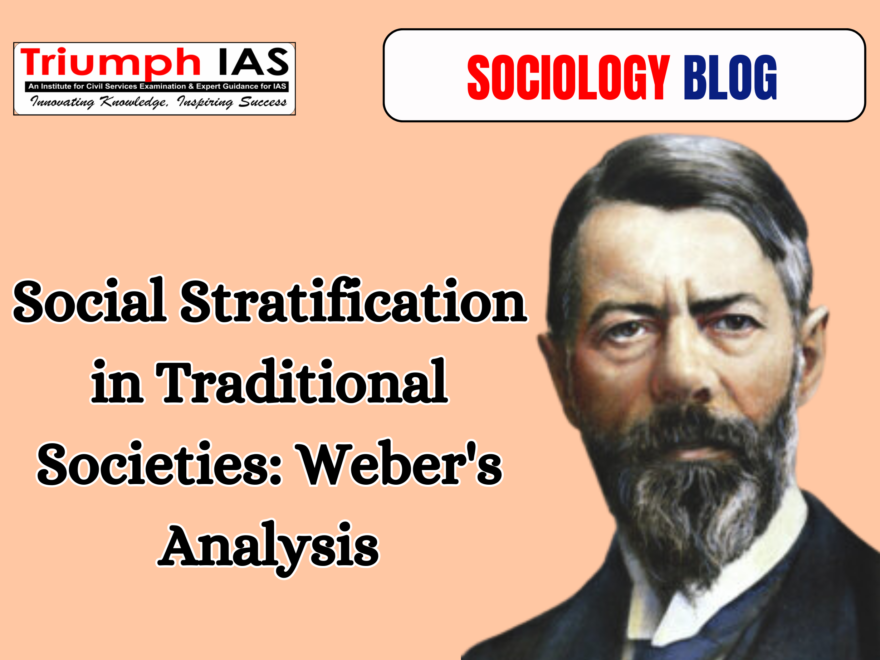Social Stratification in Traditional Societies: Weber’s Analysis
Relevant for Sociology Optional for Civil Service Examination.
Relevance : Sociology Paper 1 , UNIT 5 STRATIFICATION AND MOBILITY
Social Stratification in Traditional Societies: Weber’s Analysis
-
Social Stratification
- Inequalities are arranged on three dimensions, but all are forms of power. In Weber’s terminology, power is the capacity to get done what you want despite resistance from others. For example, economic wealth is a form of power, giving the capacity to get what one desires. All forms of inequality are inequalities in power.
- The three dimensions of power are
(1) economic power
(2) prestige power
(3) political power.
- They are the basis for three characteristically different forms of grouping: the class, the status group and the party. It is among and between these three kinds of groups that the historically decisive struggles over power are about to take place.

Classes
- Weber’s conception of social class is much akin to Marx’s. Class is defined in terms of position in the process of economic production, specifically in terms of one’s relationship to a market: what does one have to sell on the market? Is it labour power, or does one have products, or what? Weber does not think of classes as real groups, i.e. person’s self- consciously interacting with one another; rather, they are merely categories, the product of a sociological analyst’s definitions.
- A class is more a category than a group,e. a collection of people identified together on the basis of some common characteristic. We can have as many or as few classes as we like, depending on how grossly or finely we draw the criteria.
- Key points regarding Weber’s concept of class:
-
-
- Class as Economic Position: Weber acknowledges the importance of economic factors in defining class. He defines class as a group of individuals who share a similar economic situation or “market position.” This means that individuals in the same class have similar access to economic resources, such as wealth, income, and property.
- Market Situation: Weber’s notion of class is closely linked to an individual’s position in the market or the economy. For example, those who own and control productive resources (capitalists) are in a different class from those who sell their labor (wage laborers or the working class). This economic division is an essential aspect of class in Weber’s framework.
- Class Boundaries: Weber recognizes that class boundaries are not always rigid or strictly defined. He acknowledges that there can be various gradations within classes and those individuals may move between classes over time. For instance : Within just the one category, e.g. those (workers) who sell labour power, we can increase the number of categories by distinguishing the broad kinds of labour power sold, e.g. is it skilled or unskilled, manual or non-manual . Class is not solely determined by a person’s wealth but also by their access to market opportunities.
- Life Chances: Weber introduces the concept of “life chances” to explain how an individual’s class position affects their opportunities and outcomes in life. People in different classes have different life chances, including access to education, healthcare, and social networks. Class influences one’s ability to pursue opportunities and achieve success.
- Cultural and Social Factors: Unlike Marx, who primarily focused on economic factors, Weber incorporates cultural and social factors into his analysis of class. For example, an individual’s education, occupation, lifestyle, and social prestige are also considered in Weber’s understanding of class. These factors contribute to a person’s social status or “status group.”
-
- Not naturally unified : Contrary to Marx’s assumption, there is nothing naturally unified about a class, and the social conditions which cause classes to act as coordinated social units in the struggle for power only rarely arise. The members of a class often react to situations in the same way—what Weber termed ‘mass action’—because, of course, they share a similar background and experience, but they are not aware of one another’s response and are certainly not acting out of any sense of a joint venture in so responding.
-
-
- Class, Status, and Party: Weber’s approach to class intersects with two other dimensions of social stratification: status and party. While class refers to economic position, status refers to social prestige and honor, and party relates to political power and influence. These dimensions often intersect and collectively shape an individual’s social position.
-
Status groups
- A status group is a collection of people who recognize themselves as equals, who look upon one another as equally worthy, and who look up to and down on other social groups. Status groups are differentiated by prestige, i.e. the level of esteem in which people hold themselves and are held by others.
- A status group involves shared understandings, mutual recognition among its members and, of course, acknowledgement from its superiors and inferiors of its standing in the general scale of social position.
- Thus there is mutual awareness and some—at least diffusely—co-ordinated action integral to the very existence of a status group. The mechanism of such a group’s existence is closure. It includes some and excludes others; it takes steps to ensure that those who are not equals are kept out.
Key elements of Weber’s idea of status groups:
- Consumption-Oriented Definition: According to Weber, status groups are defined primarily in terms of consumption patterns, not in terms of their roles in production or the economy. In other words, what sets a status group apart is how its members live and the lifestyle they lead.
- Lifestyle as a Basis for Recognition: Members of a status group are recognized as equals based on their shared lifestyles. For instance, leading a life characterized by education, culture, and leisure is a common characteristic of a particular status group. The lifestyle itself becomes a basis for mutual acknowledgment and differentiation from other groups.
- Economic Inequality and Lifestyle: While the status group is primarily defined by lifestyle, economic inequality plays a crucial role in shaping these lifestyles. To lead a certain kind of life, individuals within a status group need the wealth or resources to support it. It’s not merely the possession of wealth but the capacity to fund a particular lifestyle that is decisive.
- Economic Intervention and Closure: Status groups often seek to preserve their existence and identity through practices of closure. Closure involves taking economic actions to restrain market forces. These actions aim to prevent elements of a particular lifestyle from becoming widely accessible for purchase. By restricting access to certain markers of their lifestyle, status groups can maintain their distinctiveness and keep these markers from becoming solely associated with wealth.
- Reduction of Market Conditions: The existence of status groups, defined by their shared lifestyle and social prestige, is seen as counterproductive to the operation of market conditions conducive to the formation of social class. In other words, status groups may limit the operation of market forces that would otherwise lead to the emergence of social class divisions.
- For instance the Indian caste system is the extreme case of a status group system, where the operation of the market has been restricted to such an extent that even jobs are retained within the various caste groups through inheritance.
- Conditions for Status Groups: Weber suggests that status groups tend to thrive in situations of long-term social stability. In such stable contexts, where traditional norms and values are dominant, status and prestige hold prominence. This is exemplified in Weber’s discussion of traditional societies like China and India.
Parties
Weber’s understanding of parties goes beyond formal political organizations and delves into the broader context of organized groups and associations that aim to attain and exercise power.
The key points about Party
- The Nature of Parties: Weber defines a party as an organized entity created explicitly for the purpose of pursuing and acquiring power. Unlike status groups, which may have a diffuse sense of solidarity and common interests, parties are characterized by a focused and self-conscious pursuit of power.
- Varied Contexts: Parties, as conceived by Weber, are not limited to traditional political parties but encompass any organized association developed with the specific goal of gaining power. This definition includes a wide range of contexts, such as business factions, leisure organizations, religious groups, and large-scale political entities.
- Self-Awareness and Shared Goals: Parties, according to Weber, exhibit certain characteristics, including self-awareness, mutual recognition among members of shared specific purposes, and the capacity for closely coordinated actions to achieve these objectives.
- Pursuit of Power: Parties are regarded as the most effective vehicles for the struggle for power within society. They strategize to maximize their chances of attaining power and are organized specifically for this purpose.
- Diverse Membership: While parties can choose to base themselves in specific social groups or classes, they are not limited to this approach. Parties may aim to secure power for goals and interests that are not tied to a particular class and may recruit members from various social categories.
Reference: Static Portion
Related Blogs…
 |
 |
Frequently Asked Questions:
1. Question: Define the term “ethnic movement” and provide an example from India.
Answer: An ethnic movement refers to a collective effort by a group sharing common cultural, linguistic, or religious traits, seeking to assert their identity and rights; an example from India is the Khalistan Movement in Punjab.
2. Question: Identify the main objectives behind the Gorkhaland ethnic movement.
Answer: The Gorkhaland ethnic movement primarily seeks to establish a separate state for India’s Nepali-speaking population in the Darjeeling region, advocating for linguistic and cultural recognition and political autonomy.
3. Question: What was the Operation Blue Star, and which ethnic movement was it related to?
Answer: Operation Blue Star was a military action in 1984, aiming to remove Sikh militants hiding in the Golden Temple in Amritsar; it is related to the Khalistan movement, which sought a separate Sikh country.
4. Question: Mention a critical factor that triggered the emergence of ethnic movements in India, as discussed by Dipankar Gupta.
Answer: Dipankar Gupta emphasized that ethnicity is fundamentally a political process, wherein caste and religion, the key components of identity formation, are politicized by leaders for vested interests.
5. Question: What were the primary reasons for the Assam Ethnicity conflicts involving Bodo tribals and Bengali Muslim settlers?
Answer: The Assam Ethnicity conflicts primarily stemmed from issues related to immigration, land rights, and resource allocation, leading to clashes, riots, and evolving relationships among indigenous communities to address challenges.
6. Question: Briefly describe the role of the Dravidian Movement in terms of caste and societal structure.
Answer: The Dravidian Movement, led notably by E.V. Ramasamy, aimed to establish an egalitarian society, focusing on anti-Brahmanism and advocating for equal rights for backward castes, while also introducing reforms like self-respect marriages.
7. Question: Name the prominent ethnic movements in North-East India and specify one common objective.
Answer: Prominent ethnic movements in North-East India include the Nagas’ and Mizos’ struggles; a common objective was to gain autonomy and recognition for their distinct tribal identities and cultural uniqueness.
8. Question: What is the key argument of Gail Omveldt regarding traditional Indian society and multiculturalism?
Answer: Gail Omveldt opposed romanticizing traditional Indian society, arguing that hierarchy has always dominated it and dismissing the notion that multiculturalism is an intrinsic feature of Indian society as a myth.
9. Question: Briefly explain the social hierarchy factor as a contributing element to ethnic movements as suggested by Olzak.
Answer: Olzak suggests that the construction of hierarchies among ethnic communities, which often leads to the suppression of one group by another, is a key factor that can instigate social and ethnic movements.
10. Question: Identify one consequence of the unequal economic development factor within the context of ethnic movements in India.
Answer: One consequence of unequal economic development is the marginalization and underdevelopment of certain groups, leading to feelings of alienation and sometimes initiating ethnic movements as these groups strive for equality and recognition.
GS Related Practices Questions…
To master these intricacies and fare well in the Sociology Optional Syllabus, aspiring sociologists might benefit from guidance by the Best Sociology Optional Teacher and participation in the Best Sociology Optional Coaching. These avenues provide comprehensive assistance, ensuring a solid understanding of sociology’s diverse methodologies and techniques.
META TAGS:
Ethnic Movements, ethnic movements in india, ethnic movement in sociology, Punjab Movement, North-East Ethnic Movements, Gorkhaland Movement, Dravidian Movement, Assam Ethnicity, Ethnic Conflicts, Sociopolitical Impact, India, Ethnic Consciousness, Ethnic Rights, Political Crisis, Economic Development, Cultural Disparities, Khalistan Movement, Nagaland, Mizoram, Multiculturalism, Political Economy, Identity Formation, Social Hierarchies, Bodo Tribals, Bengali Muslim Settlers, Anti-Sikh Riots, Operation Blue Star, Unequal Development, Ethnic Violence, Political Mobilization

Why Vikash Ranjan’s Classes for Sociology?
Proper guidance and assistance are required to learn the skill of interlinking current happenings with the conventional topics. VIKASH RANJAN SIR at TRIUMPH IAS guides students according to the Recent Trends of UPSC, making him the Best Sociology Teacher for Sociology Optional UPSC.
At Triumph IAS, the Best Sociology Optional Coaching platform, we not only provide the best study material and applied classes for Sociology for IAS but also conduct regular assignments and class tests to assess candidates’ writing skills and understanding of the subject.
Choose The Best Sociology Optional Teacher for IAS Preparation?
At the beginning of the journey for Civil Services Examination preparation, many students face a pivotal decision – selecting their optional subject. Questions such as “which optional subject is the best?” and “which optional subject is the most scoring?” frequently come to mind. Choosing the right optional subject, like choosing the best sociology optional teacher, is a subjective yet vital step that requires a thoughtful decision based on facts. A misstep in this crucial decision can indeed prove disastrous.
Ever since the exam pattern was revamped in 2013, the UPSC has eliminated the need for a second optional subject. Now, candidates have to choose only one optional subject for the UPSC Mains, which has two papers of 250 marks each. One of the compelling choices for many has been the sociology optional. However, it’s strongly advised to decide on your optional subject for mains well ahead of time to get sufficient time to complete the syllabus. After all, most students score similarly in General Studies Papers; it’s the score in the optional subject & essay that contributes significantly to the final selection.
“A sound strategy does not rely solely on the popular
Opinion of toppers or famous YouTubers cum teachers.”
It requires understanding one’s ability, interest, and the relevance of the subject, not just for the exam but also for life in general. Hence, when selecting the best sociology teacher, one must consider the usefulness of sociology optional coaching in General Studies, Essay, and Personality Test.
The choice of the optional subject should be based on objective criteria, such as the nature, scope, and size of the syllabus, uniformity and stability in the question pattern, relevance of the syllabic content in daily life in society, and the availability of study material and guidance. For example, choosing the best sociology optional coaching can ensure access to top-quality study materials and experienced teachers. Always remember, the approach of the UPSC optional subject differs from your academic studies of subjects. Therefore, before settling for sociology optional, you need to analyze the syllabus, previous years’ pattern, subject requirements (be it ideal, visionary, numerical, conceptual theoretical), and your comfort level with the subject.
This decision marks a critical point in your UPSC – CSE journey, potentially determining your success in a career in IAS/Civil Services. Therefore, it’s crucial to choose wisely, whether it’s the optional subject or the best sociology optional teacher. Always base your decision on accurate facts, and never let your emotional biases guide your choices. After all, the search for the best sociology optional coaching is about finding the perfect fit for your unique academic needs and aspirations.
To master these intricacies and fare well in the Sociology Optional Syllabus, aspiring sociologists might benefit from guidance by the Best Sociology Optional Teacher and participation in the Best Sociology Optional Coaching. These avenues provide comprehensive assistance, ensuring a solid understanding of sociology’s diverse methodologies and techniques. Sociology, Social theory, Best Sociology Optional Teacher, Best Sociology Optional Coaching, Sociology Optional Syllabus.
Best Sociology Optional Teacher, Sociology Syllabus, Sociology Optional, Sociology Optional Coaching, Best Sociology Optional Coaching, Best Sociology Teacher, Sociology Course, Sociology Teacher, Sociology Foundation, Sociology Foundation Course, Sociology Optional UPSC, Sociology for IAS,
Follow us :



Find More Blogs…
| Compare and contrast Karl Marx’s and Max weber’s | Karl Marx- Historical Materialism |
| Talcott Parsons : Social system | Scope of the subject and comparison with other social sciences |
KEYWORD: Social stratification, , Economic power, Social stratification, Political power, Social stratification, Life chances in social class, Social stratification, Social stratification, Economic inequality, Social stratification, Social stratification in india


